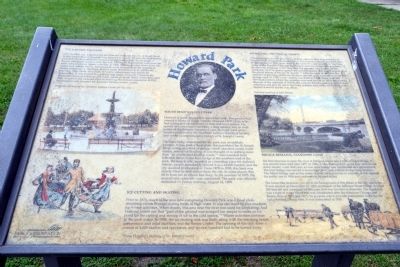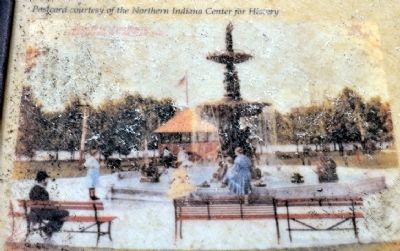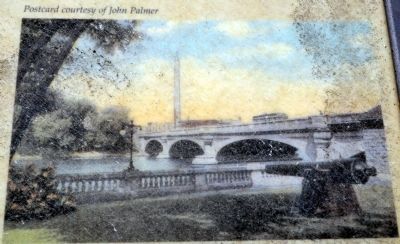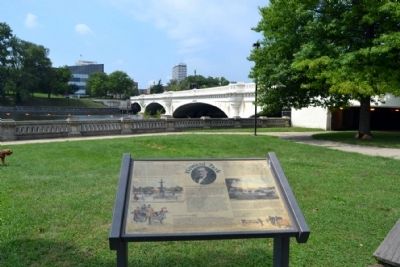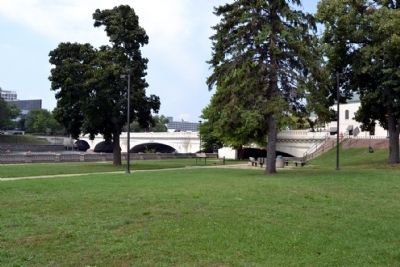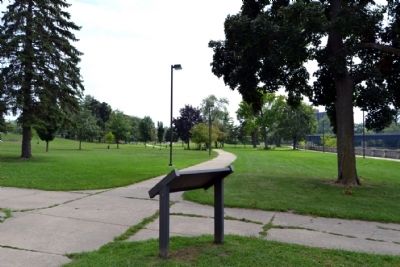Northeast South Bend in St. Joseph County, Indiana — The American Midwest (Great Lakes)
Howard Park
South Bendís Oldest Park
Howard is South Bendís first and oldest park. The ground was named in honor of Judge Timothy Howard (1837-1916), who had a long and varied career in state and local politics. He served as a city council member, a state senator, and as chief justice of the Indiana Supreme Court. Howard went on to become president of the Northern Indiana Historical Society, and wrote a comprehensive history of St. Joseph County.
The land being considered for the park was an unlikely location. It was then a flood plain that paralleled the St. Joseph River, acting as a kind of sponge which absorbed excess water during periods of flooding. It was thought of as nothing more than “an overflowed swamp waste,” (*From Howardís History of St. Joseph County) and extended from Jefferson Street to the foot bridge at the southern end of the park. Because it was regarded as a breeding place for malarial insects, people mistakenly viewed it as a health hazard, and the city decided to eliminate it. From 1878 to 1895, this land was slowly filled in with refuse from the city. In some places, this fill is from ten to fifteen feet deep. In the summer of 1895, the seawall and sidewalk were completed. The park was officially dedicated on Friday evening, August 18, 1899.
The Electric Fountain
July 21, 1906, was a special day for Howard Park and the city of South Bend. A new and elaborate fountain was donated to the city by John M. Studebaker, president of the Studebaker Manufacturing Corporation. It was made of bronze and stood about twenty feet tall. The top of the fountain was encircled with colored electric lights, a novelty in 1906. Water cascaded down from the upper and middle basins, and sprayed out in streams from the mouths of turtles positioned in the large, bottom basin. But time took its toll on the fountain. After thirty-five years, it became dilapidated and had to be dismantled. It was moved to a golf driving range, formerly found on the southeast corner of Jefferson and Eddy Streets in South Bend. Some time after 1941, as part of the national drive to build up the federal arsenal for WWII, the fountain was donated for the manufacture of armaments.
Ice Cutting and Skating
Prior to 1878, much of the area now comprising Howard Park was a flood plain, absorbing excess flowage during times of high water. It was also used by area residents for winter activities. When frozen, this area near the river was used for ice skating. And Howard points out that “part of the ground was scooped out deeper to make an ice pond for the cutting and storing of ice in the cold season.” (*From Howardís History
of St. Joseph County) Winter activities continue in the park today. In 1958, the ice-skating rink was built, along with the warming house, concessions and toilet facilities, and the Senior Center. The opening of the rink drew a crown of 4,000 skaters and spectators, and several hundred had to be turned away.
Protecting the “Fair St. Joseph”
This postcard from 1918 shows one of three cannons that were formerly in Howard Park along the St. Joseph River. The cannons, placed along the bank in the summer of 1895, were used in the Civil War and donated by the Grand Army of the Republic to honor South Bend veterans. Judge Howard states, in the flowerly language of the time, that the cannons were poised on the riverbank “as if on guard against any possible enemy that might appear upon the placid bosom of the fair St. Joseph.” (*From Howardís History of St. Joseph County) After a couple of decades, the cannonís supporting platforms decayed, and the guns were taken to the cityís storage yard. In 1928, a new armory was built in South Bend (now the Newman Center), where the cannons were sent for use as lawn decorations. Because of the outbreak of WWII, the cannons became part of a nation-wide collection and sent by rail to the Gary, Indiana steel mils, where they were melted down to aid the war effort.
Bridge Remains,
Standpipe Gone
The first structure to span the river at Jefferson Street was a frail, wooden bridge. It was erected some time after 1875. In 1883, it was destroyed by an ice flow and carried down stream. Later that year, an iron truss bridge was constructed as a replacement. The iron bridge was moved to Ironwood Drive, and a Melan bridge took its place. The Melan bridge uses arches made of steel ribbing buried in concrete. It was opened for public use in 1906 and continues to be used today.
The tower-like structure you see in the background of this photo is the city standpipe. It was erected on November 17, 1873, northwest of the Jefferson Street bridge. It stood 200 feet tall and contained an iron pipe that was five fee tin diameter. The standpipe was a type of water tower that was constructed after the infamous Chicago and Boston fires of 1871 and 1872. Its purpose was to provide pressurized water for the task of extinguishing fires. It was dismantled in 1930.
Erected by South Bend Parks & Recreation Department.
Topics. This historical marker is listed in these topic lists: Bridges & Viaducts • Settlements & Settlers • Waterways & Vessels. A significant historical date for this entry is July 21, 1906.
Location. 41° 40.489′ N, 86° 14.643′ W. Marker is in South Bend
, Indiana, in St. Joseph County. It is in Northeast South Bend. Marker can be reached from S. St. Louis Boulevard south of E. Jefferson Boulevard, on the right when traveling south. Marker is located in the northwest corner of Howard Park; the above directions are to the parking lot for the park. Touch for map. Marker is in this post office area: South Bend IN 46617, United States of America. Touch for directions.
Other nearby markers. At least 8 other markers are within walking distance of this marker. History of Howard Park (within shouting distance of this marker); A Window To Our Past (about 500 feet away, measured in a direct line); The Original People (about 500 feet away); St. Joseph County Vietnam Veterans Memorial (about 600 feet away); 9/11 Memorial (approx. 0.2 miles away); COVID-19 Pandemic Memorial (approx. 0.2 miles away); Special Olympics Island (approx. 0.2 miles away); Knute Rockne (approx. 0.3 miles away). Touch for a list and map of all markers in South Bend.
Credits. This page was last revised on February 4, 2023. It was originally submitted on September 26, 2014, by Duane Hall of Abilene, Texas. This page has been viewed 520 times since then and 22 times this year. Photos: 1, 2, 3, 4, 5, 6. submitted on September 26, 2014, by Duane Hall of Abilene, Texas.
